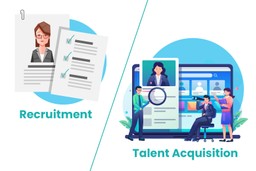There exist a stereotype that “recruiting” and “talent acquisition” are synonyms. While it’s not true, they both focus on hiring amazing people but differ from each other in approach. Recruiting simply comes as a short-term process of choosing an individual for an available role. Talent acquisition, on the other hand, requires a more long-term plan of identifying, recruiting, and retaining human resources.
It’s of indispensable necessity to understand the distinction between these two approaches to bring more productive talent to your business or organization.
Our today’s article will look at the major differences between recruitment and talent acquisition. Then, we’ll point out which strategy you should prioritize as well as recommend a powerful HR tool to maximize your talent acquisition.
What Are the Differences between Recruitment and Talent Acquisition?
Recruiting refers to the process of sourcing, profile screening, interviewing, selecting, and hiring candidates to fill in available job vacancies. Everything is standardized and HRs just need to follow this pre-defined process when there is a staff turnover or business expansion.
Talent acquisition concentrates more on positioning a company as an attractive destination for top talent. To achieve that, companies must go through a strategic process that helps identify, attract, onboard, and train the best employees. Besides a hiring plan, you need to centralize recruitment marketing, employer branding, and even performing talent analytics.
That’s said recruiting is a subset of talent acquisition.
Differences between Recruitment and Talent Acquisition
There are some significant differences between talent acquisition and recruiting that you should pay attention to when considering one of these 2 hiring strategies for your business.
Basically, recruitment is an action of solving an immediate problem which is filling an open position. When you successfully hire an employee, your job is done there. Talent acquisition, meanwhile, is a whole strategic approach to developing a talent pipeline, from hiring to retaining.
- Branding Marketing
Employment branding should be taken into account when it comes to attracting talent. You may not notice but nearly 7 out of 10 job seekers will refuse a company with a poor brand reputation, even with a high income, according to a study from MRINetwork.
Talent acquisition requires you to build a corporate and positive company culture to deliver a good experience for candidates. Although recruiting also forms a good culture for your business, TA makes it more long-term.
- Involvement
You can distinguish recruiting and talent acquisition based on the steps involved in their processes.
When an HR staff plans to recruit someone for a vacancy, they need to post the job on the company website or job boards, source and screen resumes, interview candidates, conduct talent assessments, and select and hire one of these qualified people.
Talent acquisition does more than just hiring people. Their main goal is also to engage, retain, and develop these candidates so they can contribute to the success of the company in the long run.
- Planning
Recruiting ends right when you hire someone and have them onboard. However, talent acquisition needs more planning. You have to look at and predict trends in the job markets. For example, if there is a growing demand for employees in a specific field, the TA team should be aware of and stay ahead of that trend to acquire the best talent for the company.
- Knowledge
When hiring a person for the company, recruiters aren’t forced to fully understand the job that they attempt to fill, but talent acquisition is. They just need to gather some information from department heads and come up with a job description.
TA demands more knowledge and assessing skills to ensure the candidate is a good match for the position and company culture, including their experience, interests, and preferences. Not only does it help reduce the turnover rate but also saves time and money to rehire.
- Candidate Sourcing
Recruiting and talent acquisition search for talent and sourcing potential candidates in the same way which is from various sources, from career pages to job sites and job fairs. Then you’ll contact them and offer them the job.
Out of the box, talent acquisition goes further than that. Your job focuses on building relationships with candidates. Even if they fail your requirement or refuse the offer right now, it doesn’t mean you completely lose them. You can keep their contact for future opportunities.
Why Should You Prioritize Talent Acquisition over Recruitment?
While both talent acquisition and recruiting are critical components of any organization’s staffing strategy, the former should be given priority over the latter.
Several reasons motivate you to do that, especially when plan to:
- Grow your business quickly – Your company can’t look forward to a fast-growing future without taking advantage of a solid talent acquisition strategy. It allows reducing the risk of hiring the wrong people or losing your culture.
- Attract niche talent – Specialized industries like Technology, Medicine, Finance, or Legal require candidates with the right skill set. Fortunately, the TA team with enough knowledge and understanding about the job can identify the right people. Plus, employees in these hot niches are often in high demand, that’s why you’ll need a talent acquisition strategy to stand out from competitors.
- Grow your talent pool – A talent acquisition strategy gives you a helping hand in growing and nurturing your candidate pool. As a result, you can have more available options to choose from when in demand.
- Make faster and better hiring decisions – Since you already have a long-term plan, talent acquisition makes it simpler to proactively find the perfect fit for your vacancies.
Jumpstart Your Talent Acquisition Strategy
Recruiting scrutinizes candidates to see if they’re a good fit for the company when talent acquisition convinces talent that your company is the right place for their career expectations. And that’s the critical difference between these two hiring strategies.
Talent acquisition has been increasingly popular thanks to its outstanding benefits over recruiting. However, it requires some marketing efforts and the right tool to build a strong and effective talent acquisition strategy.
bravoSUITE provides you with an all-in-one HR platform for your talent acquisition. It is of help to not only acquire the right people for your organization but also understand and develop their strengths, engage employees, and make critical decisions via valuable insights. Curious about how the tool’s power in creating your talent acquisition strategy? Don’t miss the chance to register for our 21-day free trial!








